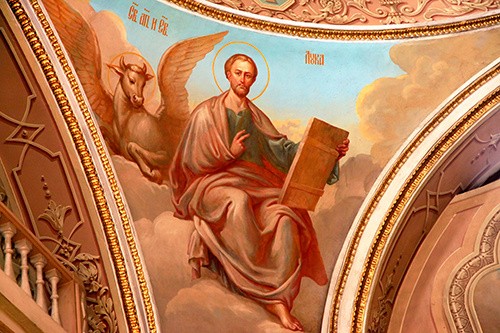
This Gospel appears to have been written about the same time as Matthew’s, although later revisions are always possible. It seems that neither writer was aware of the other’s work. The text probably originated around the Aegean Sea or in Asia Minor. The Gospel is the first part of a two-volume work which also includes the Acts of the Apostles.
Luke apparently has two related interests. To non-Christians in the Roman Empire, he wishes to portray the Church as “a philosophically enlightened, politically harmless, socially benevolent, and philanthropic fellowship.” He presents Christianity as a religion for Jews and Gentiles worthy of legal recognition by the Roman Empire. Luke offsets the embarrassing fact that the Church’s founder had been executed for sedition by a Roman prefect by having Pilate declare Jesus innocent three times [23:4, 14, 22]. Furthermore, in Luke, the centurion at the foot of the cross (unlike in Mark and Matthew) exclaims, “Surely, this man was innocent.” [23:47] It is also not an accident that almost every Roman character in Luke-Acts is portrayed favorably.
To members of the church, Luke has a second goal. Because in his time and place the church’s proclamation to Jews is failing, but succeeding in terms of Gentiles, some are apparently wondering if God had been faithful to the promises to the people of Israel that they would be blessed. If blessing through Christ was now shifting onto Gentiles, what did that say about divine promises to Jews? Or was the church a heretical deviation from Judaism as some were charging? Luke’s reply is to stress that the church began, as God so willed, among pious, law-abiding Jews (including Jesus!) and that Jewish-Christians form the irreplaceable Jewish heart of an increasingly Gentile church. Through them comes “a light for revelation to the Gentiles and glory to [the] people Israel.” [2:32]
Luke’s portrait of Jesus relates to these purposes. For Luke, Jesus is the bringer of authentic peace, of spiritual and physical wholeness, and of healing and reconciliation. Therefore, the icon for this Gospel is a dove of peace. At the Lucan Jesus’ birth, angelic messengers proclaim “Good news of great joy for all the people: to you is born this day . . . a Savior! . . . Peace on earth among those whom God favors!” [2:10-11, 14] These words echo monument inscriptions which praised Augustus Caesar as “god” and “savior,” the bringer of the Roman Peace, whose birth “marks the beginning of good news, through him, for the world.” Luke is hereby claiming that Jesus completes more fully the work of Augustus. He is the one who brings true peace in the world. Similarly, the Lucan John the Baptist is described as one who will “guide our feet into the way of peace.” [2:14]
In Luke’s Gospel, Jesus is surrounded by an aura of healing and reconciliation that affects all who come into contact with him. This Lucan trait can be seen in several unique passages in his Passion Narrative. It is only in Luke that Jesus heals the servant’s ear that was severed during the scuffle at Jesus’ arrest [22:51]. Only in Luke do Herod Antipas and Pontius Pilate become unlikely fast friends after being in Jesus’ presence [23:12]. Jesus prays for forgiveness for his crucifiers only in Luke’s Gospel [23:34]. And only in Luke does one of those crucified with Jesus express faith in him [23:39-43].
There is also a Lucan theme that sees Jesus as the Ultimate Prophet who is fated to die in Jerusalem as prophets before him.
Connected with this Christology is Luke's concern for those marginalized in first-century society. The poor, the oppressed, the diseased, and women all receive special attention in this Gospel. Christians are expected to address the physical needs of people, particularly the disadvantaged, and see to it that none go hungry or without shelter. The rich are shown in Luke as finding it especially difficult to detach themselves from their possessions, although those few who do so are praised [e.g., Acts 4:32-37].
The main christological perspective in Luke is that Jesus is the one who brings shalom, that is, peace, healing, reconciliation, forgiveness, and wholeness. He brings God’s promises of blessings for the world through Israel to fulfillment. Authentic discipleship is defined by promoting the well-being of all, especially the marginalized, and by fostering peace and unity.
Luke Timothy Johnson, Luke [Sacra Pagina] (Collegeville: Liturgical Press, 1991), p. 9.


